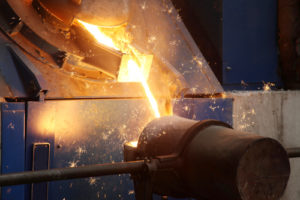Die casters usually implement zinc die casting finishing processes as a means of improving the performance and physical appearance of the final product. The metals and alloys used for zinc casting are suitable for several finishing processes, due to their high durability and excellent physical properties.
Zinc die casting finishing processes do not generally improve the aesthetic of the final product; rather, it boosts its electrical conductivity. In some cases, die casters also make the finished product highly resistant to corrosion, chemicals, and wear, by implementing accurate finishing processes. In addition to this, such finishing techniques and processes can also be used to remove burr and other flaws in the finished product.
Most expert die casters would be able to point out the most accurate and appropriate finishing methods to use, right from the early design stage of the die. However, in some rare cases, die casters may subject the finished product to a few more processes in order to improve its efficiency or physical properties.
Preparing the product surface is the first and foremost thing a die caster does before proceeding to zinc die cast finishing. If they ignore this step, the finishing process might not be able to resolve the structural issues in the product. Moreover, even slight imperfections in the product could get emphasized if the surface is not effectively prepared prior to finishing.
It is best to maintain regular contact with your die casting company right from the beginning stages. This allows you to provide suggestions and ideas. In addition to that, you would be able to make a few changes to the design of the die.
Things to know about Die Casting Finishing Treatments
Each type of zinc die casting finishing process has its own specific set of characteristics. The money you would need to spend will also significantly vary from one process to another. In some rare cases, the cost of the finishing processes might even exceed the cost of die casting itself. However, if both the supplier and customer work together right from the early stage of the die casting process, they would be able to balance these costs.
Die casters usually use post-cast and thermal deburring processes on finished die cast products for the following reasons.
- To remove flashes
- To eliminated round and sharp edges
- To brighten and smoothen the rough surfaces
On the other hand, mechanical and vibratory deburring processes are usually implemented in order to achieve strengthening effects in the finished product. These processes offer greater protection to the die against corrosion, wear, and tear. In addition to that, they considerably improve the surface performance and heat dissipation properties of the die.

Zinc Die Casting
Most zinc die casting components usually undergo one to three finishing treatments, based on the requirements of the user. However, before implementing any such process, you would need to ensure that the finished product is capable of undergoing them. If you have no clue on how to do that, it is best to seek the advice of professional die casters.
Three Crucial Steps Involved in Zinc Die Casting Finishing Process
The process of zinc die casting finishing can be explained in three different stages and they are as follows.
- Deburring phase
- Surface conversion coating
- Final surface finishing
Deburring Phase
Die casters usually implement vibratory processes during this stage of the zinc die casting finishing process. These processes would remove burrs, debris, and other unnecessary particles from the die. Most finished products that are produced through the process of die casting usually undergo a mechanical deburring operation right after getting ejected from the mould.
Surface Conversion Coating
Once the deburring phase is completed, a conversion coating is applied on the surface of the finished product. This is done to remove the oil and other contaminants from the die. The coating in the product would also allow you to paint the surface of the product at a rapid pace.
Final Surface Finishing
A number of final surface finishing processes may be implemented on the finished product in order to meet the requirements of the client. Powder coatings are applied to give a uniform surface finish to the die, and to make it durable. Sometimes, electroplating is done to impart better corrosion and wear resistance to the surface of the product.
In some cases, die casters incorporate the use of a mechanical plating process. This process enables them to achieve the desired coating thickness with ease. Mechanical plating can be applied on the inside, as well as all other surfaces of the finished product. During this, the die is placed into a drum with a chemical activator and metal powders, and then these are tumbled against one another.a
